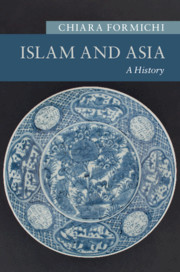Book contents
- Islam and Asia
- New Approaches to Asian History
- Islam and Asia
- Copyright page
- Dedication
- Contents
- Figures
- Maps
- Boxes
- Sources
- Preface
- Acknowledgments
- Note on Transliteration and Foreign Terms
- Maps
- Introduction
- 1 Islam across the Oxus (Seventh to Seventeenth Centuries)
- 2 Becoming Muslim (Seventh to Eighteenth Centuries)
- 3 Networks and Renewal (Thirteenth to Nineteenth Centuries)
- 4 Pan-Islamism and Nationalism (Nineteenth and Twentieth Centuries)
- 5 Muslims in the Nation-State (1940s to 1960s)
- 6 New Imaginations of Piety (1960s to 1990s)
- 7 Islam as Resistance
- 8 De-centering Islamic Authority
- 9 Studying Asia and Islam
- Glossary
- Notes
- Index
- New Approaches to Asian History
- References
3 - Networks and Renewal (Thirteenth to Nineteenth Centuries)
Published online by Cambridge University Press: 16 April 2020
- Islam and Asia
- New Approaches to Asian History
- Islam and Asia
- Copyright page
- Dedication
- Contents
- Figures
- Maps
- Boxes
- Sources
- Preface
- Acknowledgments
- Note on Transliteration and Foreign Terms
- Maps
- Introduction
- 1 Islam across the Oxus (Seventh to Seventeenth Centuries)
- 2 Becoming Muslim (Seventh to Eighteenth Centuries)
- 3 Networks and Renewal (Thirteenth to Nineteenth Centuries)
- 4 Pan-Islamism and Nationalism (Nineteenth and Twentieth Centuries)
- 5 Muslims in the Nation-State (1940s to 1960s)
- 6 New Imaginations of Piety (1960s to 1990s)
- 7 Islam as Resistance
- 8 De-centering Islamic Authority
- 9 Studying Asia and Islam
- Glossary
- Notes
- Index
- New Approaches to Asian History
- References
Summary
The intellectual biographies of the scholars presented in this chapter – Muhammad ibn ‘Abd al-Wahhab (1703–1792), Shah Waliullah Dihlawi (1703–1762), Shaykh Da’ud al-Fatani (1769–1847), ‘Abd al-Nasir al-Qursawi (1776–1812), Ma Laichi (?1681–1766), and Ma Mingxin (?1719?–1781) – lead us through an exploration of how mysticism and legal approaches to Islamic practice took shape not as mutually exclusive but rather as intertwined dynamics, highlighting a dual track of reformism and Sufism concerned with “proper” ritual, a return to the scriptures, and a rejection of bid’a, often manifested as the absorption of local traditions into Islamic practices. The specific focus on the Naqshbandiyah additionally allows us to center these dynamics in Asia, as this Central Asian order spread to the Indian subcontinent and influenced developments in China and Southeast Asia, ultimately bringing Asia center-stage when exploring scholars’ concerns (and interventions) about “deviation” and “orthodoxy”. Without denying the crucial role played by Mecca and Medina as gathering places for scholars coming from all corners of the world, this chapter has taken into consideration alternative routes and networks of religious learning that connected the umma across geographical boundaries.
Keywords
- Type
- Chapter
- Information
- Islam and AsiaA History, pp. 75 - 103Publisher: Cambridge University PressPrint publication year: 2020

